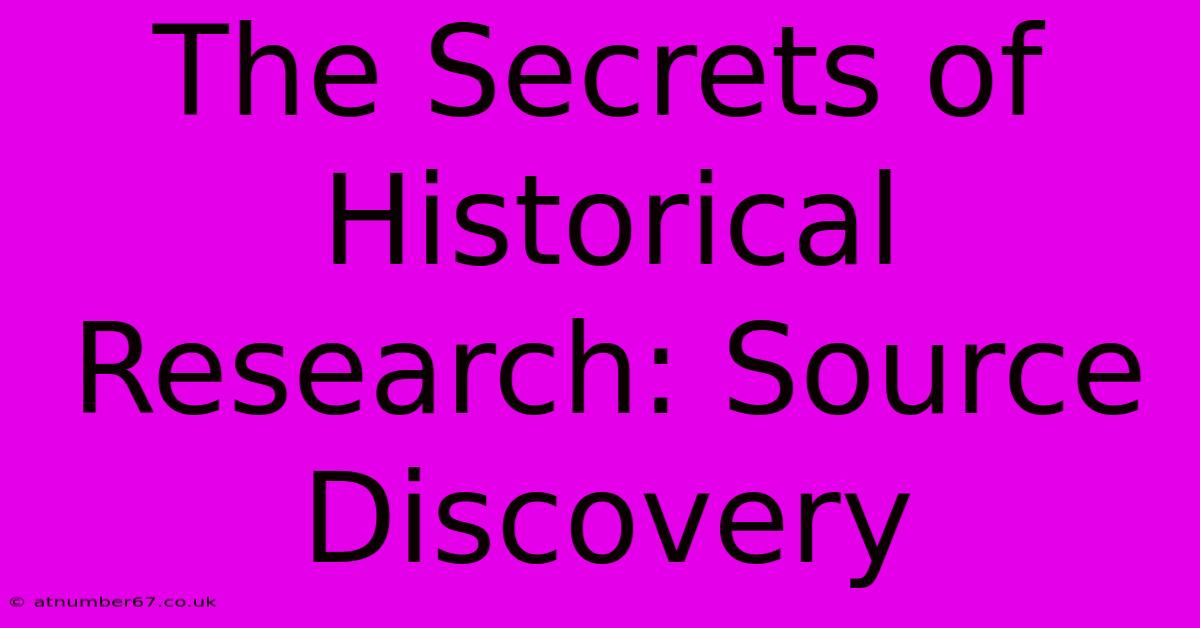The Secrets Of Historical Research: Source Discovery

Table of Contents
The Secrets of Historical Research: Unearthing the Sources
Historical research is a thrilling detective story, a quest to unravel the past using the clues left behind. But unlike fictional detectives, historians don't have a neatly organized case file. Instead, they must navigate a complex landscape of potential sources, learning to identify, evaluate, and interpret them to reconstruct a credible narrative. The most critical skill in this process? Source discovery.
This article delves into the secrets of finding those elusive historical sources, equipping you with strategies and techniques to successfully unearth the hidden treasures of the past.
Mastering the Art of Source Discovery: Where to Begin?
The starting point of any historical research project is identifying potential sources. This isn't a haphazard process; it requires a strategic approach:
1. Defining Your Research Question: The Guiding Star
Before embarking on your search, formulate a clear and concise research question. This question will dictate the types of sources you need. For example, researching the impact of the Industrial Revolution on a specific city requires different sources than exploring the personal diaries of a 19th-century immigrant.
2. Exploring Primary Sources: The Eyewitness Accounts
Primary sources are materials created during the time period you are studying. They offer unique insights and direct evidence:
- Archives: These are treasure troves of original documents, photographs, and other materials. National archives, university archives, and local historical societies often hold vast collections.
- Libraries: University and public libraries possess extensive collections of books, journals, newspapers, and other printed materials, many digitized and accessible online.
- Museums: Museums preserve artifacts, artworks, and other physical objects offering tangible connections to the past.
- Online Databases: Numerous digital archives and databases provide access to digitized primary sources, often with powerful search functionalities. JSTOR, Project Gutenberg, and Chronicling America are just a few examples.
- Oral Histories: Recorded interviews with individuals who experienced historical events can provide invaluable firsthand accounts.
3. Utilizing Secondary Sources: Building Context
Secondary sources analyze and interpret primary sources. While not offering direct evidence, they provide crucial context and existing scholarship:
- Books and Articles: Scholarly books and journal articles offer in-depth analysis and interpretations of historical events and figures.
- Bibliographies: These lists of sources cited in scholarly works can lead you to further relevant materials.
- Review Articles: These summarize existing research on a specific topic, offering an overview of the current state of scholarship.
Advanced Source Discovery Techniques: Going Beyond the Obvious
Once you've mastered the basics, consider these advanced techniques:
1. Network Analysis: Following the Breadcrumbs
Look beyond individual sources and consider the relationships between them. Who cited whom? What connections exist between different documents or individuals? This network analysis can reveal hidden connections and lead to unexpected discoveries.
2. Serendipity and Exploration: Embracing the Unexpected
Be open to unexpected findings. Sometimes, the most significant discoveries happen when you stray from your initial research plan. Explore related topics, follow tangential leads, and allow yourself to be surprised.
3. Utilizing Specialized Search Strategies: Refining Your Search
Master advanced search techniques using keywords, Boolean operators (AND, OR, NOT), and wildcard characters to refine your search and uncover more relevant sources.
Evaluating Your Sources: Critical Thinking is Key
Source discovery is only half the battle. Critical evaluation is crucial. Ask yourself:
- Authorship: Who created the source? What were their biases or perspectives?
- Context: When and where was the source created? What historical events were occurring?
- Audience: For whom was the source intended? How might this affect its message?
- Reliability: Is the information accurate and credible? Are there any inconsistencies or contradictions?
By mastering the art of source discovery and applying careful critical evaluation, you can unlock the secrets of the past and contribute to a richer understanding of history. The journey may be challenging, but the rewards are immense. The uncovering of a significant historical source is a profoundly rewarding experience, enriching not only your research but also your understanding of the world.

Thank you for visiting our website wich cover about The Secrets Of Historical Research: Source Discovery. We hope the information provided has been useful to you. Feel free to contact us if you have any questions or need further assistance. See you next time and dont miss to bookmark.
Featured Posts
-
Carles Minarro Garcias Age The Shocking Truth
Apr 01, 2025
-
The Strength Of Cooper Flaggs Mom
Apr 01, 2025
-
The Secrets To Jay Shahs Financial Success
Apr 01, 2025
-
Can Joe Biden Handle The Pressures Of His Age
Apr 01, 2025
-
Is Charles Mansons Son Alive You Wont Believe This
Apr 01, 2025
